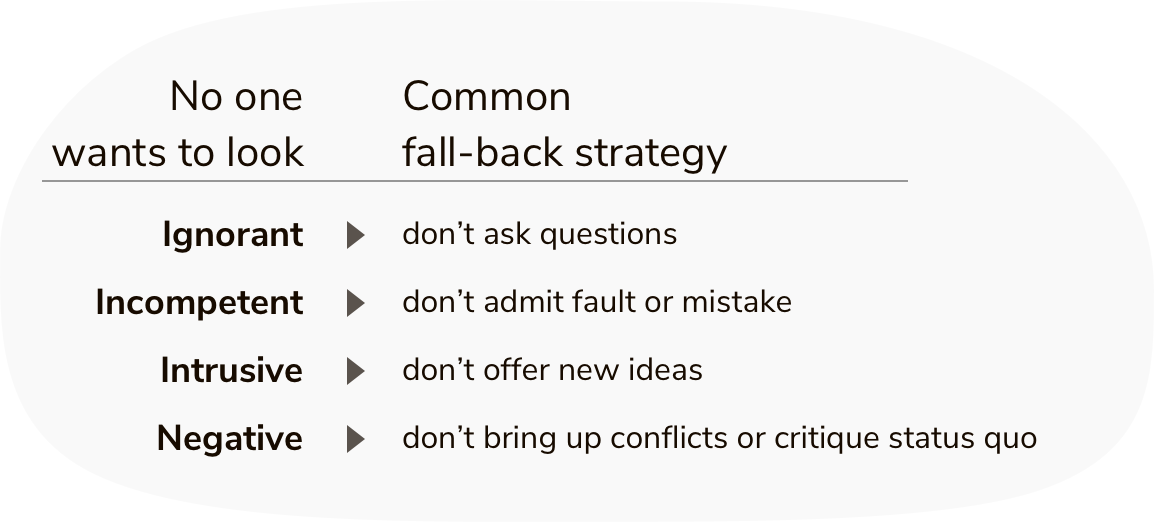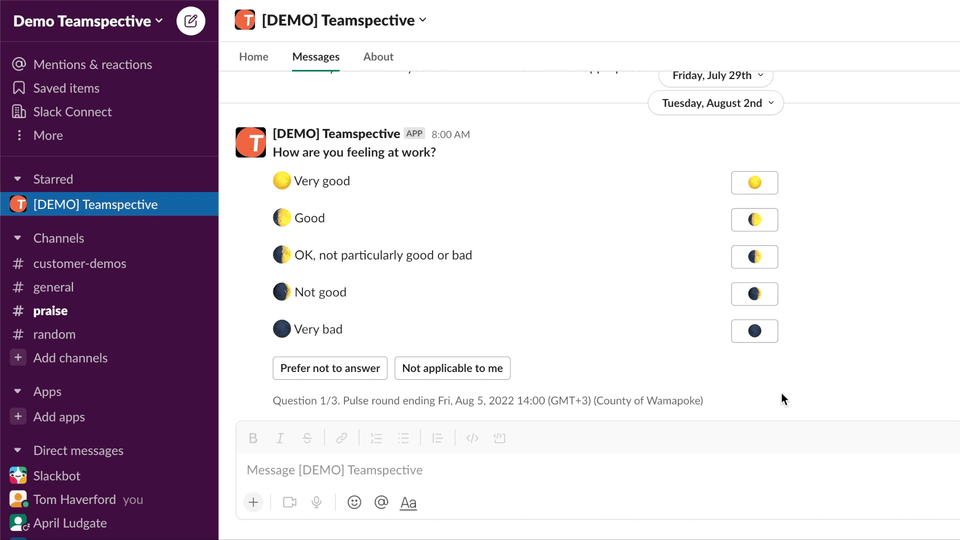Strategies for creating psychological safety
April 20, 2020Psychological safety is the most important factor for effective teamwork, as found in a study by Google. In this article, we discuss how teams can build psychological safety by creating a climate of speaking up as well as encouraging feedback, error-reporting and help-seeking.
The problem: scared people don’t speak up when they should
Picture this. You’re sitting in a meeting and haven’t contributed to the discussion in the first 30 minutes. When you get a new idea on how a major problem could be solved, you patiently wait for your turn to speak, but soon notice the chance has already passed. Others seem to have all the answers, and so you stay silent and comply with the perceived group consensus. Later you realize that your idea was in fact better and you ponder what would have happened if you spoke up. Something stopped you from sharing your idea and it still eats you.
Does this sound familiar? Because teamwork is often like that.
As Amy Edmondson explains in her TEDx talk, nobody wants to look ignorant, incompetent, intrusive or negative. Therefore, we avoid asking silly questions, and dread admitting fault publicly. For the same reason we refrain from offering new ideas or criticizing the status quo. Silence feels safer than speaking up – after all, better safe than sorry.

Most organizations advocate learning, responsibility, innovative thinking and continuous improvement. However, these are all hindered by the naturally occurring fear of sticking out. Many organizations have not found effective means to change this; Preventable problems cause destruction and great opportunities pass because of common reluctance to speak up. The dangerous part is that not speaking up is silent, so you won’t even know when people are afraid to do it.
The antidote to this fear-induced silence is psychological safety.
What is psychological safety and why should you care?
The term ‘psychological safety’ was first introduced over 20 years ago by its leading researcher, Amy Edmondson, who wrote a book about the subject, “The Fearless Organization” (Wiley, 2018).
As she explains, psychological safety describes a climate in which speaking up is enabled, encouraged and expected, and interpersonal fear is low. It means that people are not afraid to present their ideas and observations, trusting that their input will not result in backlash or other negative repercussions like judgement, shame, or punishment.
In 2016, Google finished their 2-year research on team effectiveness, named project Aristotle. They found out that psychological safety was in fact the number one success factor in their best teams. The highest-performing teams had it, while the others didn’t.
The 5 most important factors leading to team success at Google were:
- Psychological safety (speaking up is enabled, encouraged and expected)
- Dependability (trust that colleagues will deliver quality work on time)
- Structure and clarity (goals, roles and plans are clear)
- Meaning (finding personal interest to work)
- Impact (being able to notice the results of team’s work)
Project Aristotle shows that it is more important how the team works, rather than who is on the team. Personal qualities like tenure, experience, education, gender, and IQ were all absent from the list.
Your strategy for building psychological safety
The most practical way to improve psychological safety in a team or larger group is to actively help people speak up and reward speaking up. As a starting point, there has to be a momentary climate of openness and an arranged opportunity to speak up. When people do speak up, they have to be listened to until the issue or idea has been entirely explained. Finally, you need to use the information by acting on it or explaining why it will not be acted on.
Before speaking up: Create a climate and an opportunity to speak up
Let everyone know they have the permission to speak up – show that it is even expected. Here’s a small primer you can say out loud to frame learning as a priority for your team. Admit that nobody has all the answers and learning is what keeps you going. You can be a member or a manager of a team, it does not matter. Say:
“We have huge uncertainty and complexity ahead of us – it’s a part of our environment. There are important problems and opportunities we might miss. We need everyone to keep their head in the game and eyes and ears open. We want you to tell us what you see, especially if it involves a risk for us.”
It is probably not enough to talk about it once. Keep repeating the message regularly for as long as necessary. You don’t need to stop even when the climate of speaking up has been established.
Create opportunities for team members to speak up. It can be in your weekly meetings, an online tool like Teamspective, or preferably, a combination of those. Don’t force anyone into the spotlight, just let them know they’re welcome to take it. Ask questions like:
- Have we missed something important?
- What’s the worst-case scenario?
- Is something preventing us from completing our work?
- Do you get the help you need?
Once again, repetition is key. It is easy to fall back to silence.
Finally, show an example to others by talking openly about your own mistakes, or seeking help, or bring up difficult subjects with joy and gratitude.
During speaking up: Listen actively
When someone speaks up, hold back the impulse to interrupt with your own point of view. Instead, take a moment to understand where the speaker is coming from. Try some of these probing questions:
- This seems very important to you (stay silent, let them continue)
- What do you think is the biggest risk/opportunity here?
- What else should we consider?
- Is this important to someone else as well?
- How would you prioritize this?
- How would you solve this? Are there other ways to solve it?
Pay attention to your tone of voice while saying these. Be encouraging and supportive. Also, your body language might give even stronger signals than your words, so be mindful of it and try to remain at ease.
The point is to understand not only the statement, but also the concerns and personal needs leading to making that statement. As it often happens, fixing a single issue does not remove a bigger problem. When the original concern is addressed, it does not matter even if the statement is shown to be false – addressing the underlying need is a satisfying relief for everyone involved. When concerns are ignored, people will feel incompetent or intrusive, falling back to silence.
After speaking up: Use the information
Usually the people who bring up ideas or problems are willing to work on them. Give them responsibility and offer help. Empower people and support their autonomy by allowing them to set up goals and schedules whenever possible. However, giving too much burden to one person has a demotivating effect.
Another option is to decide that the discussion itself helped recognize the issue, and that it will not be solved for the time being. This should be communicated carefully to everyone involved – if not, the general consensus will be that issues are ignored and that speaking up is useless. This destroys psychological safety and makes the team leadership look inauthentic, nudging people back towards silence.
Whatever the outcome, open discussion is key. Open discussion is a prerequisite for building psychological safety, and psychological safety enables open discussion and speaking up. That’s a reinforcing cycle every team and organization should start. Software tools that build new routines and make the right to speak up explicit can be the catalyst that makes the difference.
Start measuring psychological safety and nurturing it today
Can there be success without psychological safety? Sure, but it’s less likely. Psychologically safe teams surpass other teams in productivity, quality of work, revenue, profit, innovative thinking, learning, and engagement.
Teamspective’s Pulse Surveys track psychological safety along with the other crucial metrics for employee engagement, wellbeing, and collaboration, asking about the most important and fast-changing topics most frequently. Responding to the surveys is very simple and takes just 30 seconds in Slack or MS Teams.
Pulse surveys not only measure psychological safety but can nurture it as well. An anonymous channel for sharing how employees actually feel about different aspects of their workplace lowers the threshold for having difficult but important conversations. Teams get their own reports automatically with actionable tips for these discussions and taking action.
Teamspective also lowers the threshold for people to help each other grow by providing a personal Feedback solution that encourages and reminds employees to regularly request feedback from each other and guides in formulating their feedback more constructively. Requested feedback feels safer to both give and receive. Moreover, our data shows that receiving written feedback monthly increases psychological safety up to 36%.
Try Teamspective’s Pulse Surveys and/or personal Feedback solution for free by signing up here or by booking a free call with our employee engagement experts.




